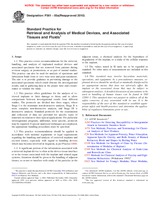Wir benötigen Ihre Einwilligung zur Verwendung der einzelnen Daten, damit Sie unter anderem Informationen zu Ihren Interessen einsehen können. Klicken Sie auf "OK", um Ihre Zustimmung zu erteilen.
ASTM F561-05a(2010)
Standard Practice for Retrieval and Analysis of Medical Devices, and Associated Tissues and Fluids (Includes all amendments And changes 10/14/2013).
Automatische name übersetzung:
Standard Praxis für die Abfrage und Analyse von Medizinprodukten und der dazugehörigen Gewebe und Flüssigkeiten
NORM herausgegeben am 1.9.2010
Informationen über die Norm:
Bezeichnung normen: ASTM F561-05a(2010)
Anmerkung: UNGÜLTIG
Ausgabedatum normen: 1.9.2010
SKU: NS-55726
Zahl der Seiten: 16
Gewicht ca.: 48 g (0.11 Pfund)
Land: Amerikanische technische Norm
Kategorie: Technische Normen ASTM
Die Annotation des Normtextes ASTM F561-05a(2010) :
Keywords:
ceramics, chemical analysis, composites, histology, implant retrieval, metals, particles, polymers, Associated tissues (surgical implants), Biocompatibility, Ceramic surgical materials/applications, Composites--surgical implants, Implantable surgical materials/applications, Metallic surgical implant materials, Nondestructive evaluation (NDE)--surgical implants, Polymers (surgical applications), Revision implant surgery, Testing methods--surgical implants, Tissue reactions
Ergänzende Informationen
| Significance and Use | ||||||||||||||||||||||||||||||||||||||||||||||||||||||||||||||||||||||||||||||||||||||||||||||||||||||||||||||||||||||||||||||||||||||||||||||||||||||||||||||||||||||||||||||||||||||||
|
The investigation of retrieved implantable medical devices and adjacent tissues can be of value in the assessment of clinical complications associated with the use of a specific prosthetic device design; can expand the knowledge of clinical implant performance and interactions between implants and the body; provide information on implant performance and safety; and thus further the development of biocompatible implant materials and devices with improved performance. Comparison of wear patterns and wear particle morphology observed with retrievals and those observed with in vitro joint simulator tests can provide valuable insight into the validity of the in vitro simulation. A significant portion of the information associated with a retrieved implant is obtained with detailed studies of the device-tissue interface. Appropriate methods are provided to facilitate a study of the particles in the tissues, and chemical analysis for the byproducts of degradation of the implant, and histologic evaluation of the cellular response to the implant. For the analysis to be accurate, it is essential that the device and associated tissues be removed without alteration of their form and structure. It is also essential that the tissues be handled in such a way as to avoid microbial contamination of the work place or the investigator. Standard protocols for the examination and collection of data are provided for retrieval and handling of implantable medical devices, as well as for specific types of materials in relation to their typical applications. For particular investigational programs, additional, more specific, protocols may be required. If special analytical techniques are employed, the appropriate procedures must be specified. In order to interpret the analysis of materials and tissues, it is also essential to capture a minimum data set regarding the clinical findings and laboratory studies documenting device performance and reasons for removal. Any destructive analysis of implants must be done so as to not destroy any features that may become the subject of litigation, as per Practice E860. This standard recommendation should be applied in accordance with state or national regulations or legal requirements regarding the handling and analysis of retrieved implants and tissues. |
||||||||||||||||||||||||||||||||||||||||||||||||||||||||||||||||||||||||||||||||||||||||||||||||||||||||||||||||||||||||||||||||||||||||||||||||||||||||||||||||||||||||||||||||||||||||
| 1. Scope | ||||||||||||||||||||||||||||||||||||||||||||||||||||||||||||||||||||||||||||||||||||||||||||||||||||||||||||||||||||||||||||||||||||||||||||||||||||||||||||||||||||||||||||||||||||||||
|
1.1 This practice covers recommendations for the retrieval, handling, and analysis of implanted medical devices and associated specimens that are removed from patients during revision surgery, at postmortem, or as part of animal studies. This practice can also be used for analysis of specimens and lubrication fluids from in vitro wear tests and joint simulators. The aim is to provide guidance in preventing damage to the associated specimens which could obscure the investigational results, and in gathering data at the proper time and circumstance to validate the study. 1.2 This practice offers guidelines for the analysis of retrieved implants to limit damage to them, and to allow comparisons between investigational results from different studies. The protocols are divided into three stages, where Stage I is the minimum non-destructive analysis, Stage II is more complete non-destructive analysis, and Stage III is destructive analysis. Standard protocols for the examination and collection of data are provided for specific types of materials in relation to their typical applications. For particular investigational programs, additional, more specific, protocols may be required. If special analytical techniques are employed, the appropriate handling procedures must be specified. 1.3 This practice recommendation should be applied in accordance with national regulations or legal requirements regarding the handling and analysis of retrieved implants and excised tissues, especially with regard to handling devices which may become involved in litigation, as per Practice E860. 1.4 A significant portion of the information associated with a retrieved implant device is often at the device-tissue interface or in the tissues associated with the implant and related organ systems. Attention should be given to the handling of adjacent tissues, so as not to interfere with study of the particles in the adjacent tissue, a chemical analysis for the byproducts of degradation of the implant, or a study of the cellular response to the implant. 1.5 The values stated in SI units are to be regarded as standard. No other units of measurement are included in this standard. 1.6 This standard may involve hazardous materials, operations, and equipment. As a precautionary measure, explanted devices should be sterilized or minimally disinfected by an appropriate means that does not adversely affect the implant or the associated tissue that may be subject to subsequent analysis. A detailed discussion of precautions to be used in handling of human tissues can be found in ISO 12891-1. This standard does not purport to address all of the safety concerns, if any, associated with its use. It is the responsibility of the user of this standard to establish appropriate safety and health practices and determine the applicability of regulatory limitations prior to use. |
||||||||||||||||||||||||||||||||||||||||||||||||||||||||||||||||||||||||||||||||||||||||||||||||||||||||||||||||||||||||||||||||||||||||||||||||||||||||||||||||||||||||||||||||||||||||
| 2. Referenced Documents | ||||||||||||||||||||||||||||||||||||||||||||||||||||||||||||||||||||||||||||||||||||||||||||||||||||||||||||||||||||||||||||||||||||||||||||||||||||||||||||||||||||||||||||||||||||||||
|



 Cookies
Cookies
